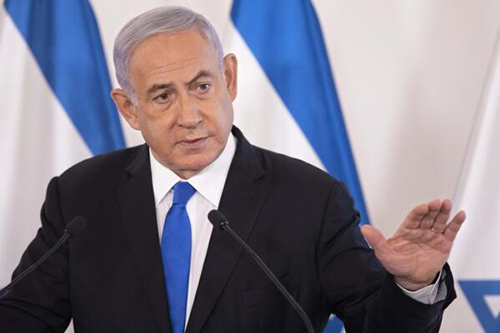|
Getting your Trinity Audio player ready...
|
Given the strategic significance of corridors, the imperative for Israel of maintaining these lines is self-evident.
By: Caroline B Glick
Currently, Israel’s media is laser-focused on the prospect of “the deal” with Hamas. Will “the deal” come to fruition or will Prime Minister Benjamin Netanyahu scuttle it?
The premise of the discourse is that “the deal,” is objectively desirable. Anyone who tells you otherwise—particularly, if his name is Netanyahu—is a liar acting solely out of personal, political and morally corrupt considerations.
Currently, Israel’s media is laser-focused on the prospect of “the deal” with Hamas. Will “the deal” come to fruition or will Prime Minister Benjamin Netanyahu scuttle it?
The premise of the discourse is that “the deal,” is objectively desirable. Anyone who tells you otherwise—particularly, if his name is Netanyahu—is a liar acting solely out of personal, political and morally corrupt considerations.
The leaders of the security establishment, including Defense Minister Yoav Gallant, Israel Defense Forces’ Chief of General Staff Lt. Gen. Herzi Halevi, Shin Bet director Ronen Bar and Mossad director David Barnea, support “the deal” and insist that Israel can live with the concessions it requires Jerusalem to make to Hamas.

Ahead of a new round of discussions about “the deal” this week in Qatar and Egypt, Netanyahu convened Israel’s negotiating team led by Barnea and Bar on Sunday. Following the meeting, the Prime Minister’s Office published five “red lines” for a deal ahead of the talks.
Broadly, “the deal” involves a six-week ceasefire during which Hamas would release 20 live, predominantly female hostages. Hamas is currently holding around 120 hostages, of whom some 80 are presumed alive. Israel would be required to release hundreds of terrorists from its prisons, including murderers, to secure the release of the 20 women.
Netanyahu’s first red line is for Israel to retain its freedom to resume offensive operations after the six-week ceasefire. Hamas long demanded that Israel concede that position and agree that the ceasefire would be permanent. Hamas is now willing to give up that demand. But it replaced it with a demand that the U.S. guarantee that Israel will not reinstate military operations in Gaza. Hamas’s reasonable assumption is that Israel will not defy the United States.
Netanyahu’s first red line makes it impossible for the administration to accept Hamas’s demand.
Netanyahu’s second red line requires Hamas to be blocked from smuggling arms from Egypt during the pause in fighting.
His third red line requires a mechanism to ensure that no armed men are able to return to northern Gaza from southern Gaza.

These two red lines come in response to Hamas’s demand that Israel withdraw its forces from the Philadelphi and Netzarim corridors during the six-week ceasefire (which Hamas, and its international supporters, seek to render permanent).
The Philadelphi corridor controls Gaza’s border with Egypt. On Oct. 7, Israel was stunned by the expanse of Hamas’s arsenal and realized that Egypt—far from acting as Israel’s partner in its effort to prevent Hamas from expanding its military power—was enabling it.
Since Israel seized control over the Philadelphi corridor, it has exposed dozens of cross-border underground tunnels. One, in particular, is a massive, three-story highway. Speaking to Amit Segal of Channel 12 news, IDF commanders said on Monday that what Israel has exposed to date is less than half of what Hamas has built yet to discover. So the situation remains threatening, and Egypt is not helping to remedy it—to the contrary.
This brings us to the Netzarim corridor, which IDF forces began constructing several months ago. The Netzarim corridor runs east to west in central Gaza. It enables Israel to control the traffic of Gazans from south to north, as well as prevents Hamas’s reconstitution of its political and military power in northern Gaza by blocking the return of its forces to the area.

Given the strategic significance of corridors, the imperative for Israel to maintain Netanyahu’s red lines is self-evident.
Netanyahu’s fourth red line requires Israel to “maximize the number of living hostages freed during the initial ceasefire.”
An all-or-nothing package
Hamas took 250 men, women and children on Oct. 7, and still holds 120 of them nine months later because it rightly views the hostages as its strategic trump card. Since 1985, when Israel agreed to swap Palestinian terrorists for Israeli hostages for the first time, every time that Iran’s terror armies have held Israeli hostages, they have successfully used them to achieve strategic gains.
If Israel removes its forces from Gaza, including from the Netzarim and Philadelphi corridors, and releases hundreds of terrorists from jail to secure the release of 20 hostages, what will it have to give to receive the release of the other 100, including 60 people presumed to still be alive?
Without troops on the ground, without the ability to reinstate combat operations, the cost of negotiating their release would be utterly prohibitive for Israel. As a result, either Israel will capitulate and start the countdown for its destruction to get them released, or it will leave the rest of the hostages in Gaza indefinitely with scant military or diplomatic prospects for their rescue.
Netanyahu’s final red line requires that “the deal” not undermine any of Israel’s war goals. This sounds redundant. But actually, it is important because it includes aspects of the deal that he doesn’t mention explicitly. One of the deal’s components being presented as “pro-Israel” stands out in particular. This component would see an “Arab force” take over security responsibility in Gaza. The idea is that forces from moderate Arab states at peace with Israel would be in charge.
There are two problems with this. First, as has been discovered regarding Egypt, ostensibly moderate and friendly Arab regimes are not necessarily moderate or friendly when it comes to Israel’s war against Hamas specifically or in relation to the Palestinian goal of annihilating Israel more generally. Bringing Arab forces into Gaza effectively merges the existential Palestinian conflict with the all-but-resolved Arab conflict with Israel. Since most Arabs support the Palestinians against Israel, this would undermine the peaceful relations Israel has built with Arab regimes across decades.

Netanyahu’s final red line would reject a deal that in any way undermines Israel’s war goals—and that includes preserving Israel’s peaceful ties with its moderate Arab neighbors.
These red lines need to be viewed as an all-or-nothing package. Either the negotiators secure all of them, or there is no deal. Their implication is obvious. Israel will accept a hostage deal. Indeed, it is willing to pay a massive price to achieve one. But it will not undermine its position strategically. It will not enable Hamas to win this war. It will not abandon the rest of the hostages. It will not sign its national death warrant.
Given the near-unanimous support of the public for the goals of the war, we should pay attention to the actors that have condemned Netanyahu’s red lines.
Aside from leftist politicians and activists, who can be expected to condemn him, Netanyahu’s red lines have also been sharply criticized by senior officers in the Mossad and the IDF. Channel 12 quoted two security sources who castigated Netanyahu’s decision to publish his red lines. “Netanyahu pretends that he wants a deal but is working to torpedo it,” one said. That source insisted that Netanyahu was acting for personal reasons.
A second source insisted that Netanyahu refuses to see the half-full side of the cup. Netanyahu, he said, “emphasizes the gaps” between Hamas and Israel, rather than the agreements they have reached to date.
Statements like these and others raise the disconcerting sense that Israel’s General Staff and its other security services reject the government’s decision to fight for victory in the war. Ynet news reported that the generals, including Gallant, believe that securing the release of 20 hostages is more important than maintaining control over the Philadelphi and Netzarim corridors. This means that they aren’t committed to the government’s war goals of defeating Hamas militarily and politically, and to preventing the terror group from rebuilding its military and political power.
Halevi’s spokesmen made the case all but explicitly in an interview Monday with ABC News.
“Will you and me be talking five years from now about Hamas as a terror organization in Gaza? The answer is yes,” said Rear Adm. Daniel Hagari, spokesman for the IDF.

The opposite side of the fence
A second source of criticism of Netanyahu’s red lines is the Biden administration.
President Joe Biden himself presented the broad outlines of “the deal” last month and insisted that it was Israel’s offer. In intervening weeks, it became clear that Biden was speaking for himself and not for Israel. True, Israel agreed to “the deal.” But it agreed to “the deal” with Netanyahu’s red lines.
The administration has been pushing full throttle for Netanyahu to accept “the deal” without his deadlines. It is reportedly threatening sanctions against Netanyahu if he rejects it. According to a high-level source, the International Criminal Court’s declared plan to issue international arrest warrants against Netanyahu and Gallant was not an ICC initiative. Rather, it was the brainchild of Maher Bitar, senior National Security Council director for the Defense Department and the Intelligence Community. Bitar, one of the most powerful officials in the administration, is a former UNRWA employee and views Israel as an illegitimate state. He also serves as special counsel to the president. Chatter is now being heard that the White House is threatening Netanyahu, saying the ICC will issue the arrest warrants if he refuses to accept “the deal.”
Rhetoric aside, given the strategic consequences of “the deal,” the administration’s clear position is that it supports Hamas’s victory over Israel in this war.
Netanyahu has long insisted that he is willing to pay an enormous price to achieve the release of the hostages. The fact that he supports “the deal” with his red lines is proof that he is telling the truth. His red lines—minimal as they are—place him on the opposite side of the fence of his detractors. They are willing to accept capitulation. He is not.
The media, the administration and the security establishment refuse to discuss the strategic implications of “the deal,” as proposed, for Israel. Instead, they harshly and hysterically condemn Netanyahu and accuse him of behaving selfishly for refusing to abandon Israel’s war goals.
Given the actual stakes, it is clear that the media is distorting events. Netanyahu is the only actor on the stage who isn’t behaving politically. He is the only one acting to protect Israel from strategic catastrophe.
(JNS.org)
Caroline B. Glick is the senior contributing editor of Jewish News Syndicate and host of the “Caroline Glick Show” on JNS. She is also the diplomatic commentator for Israel’s Channel 14, as well as a columnist for Newsweek. Glick is the senior fellow for Middle Eastern Affairs at the Center for Security Policy in Washington and a lecturer at Israel’s College of Statesmanship.





